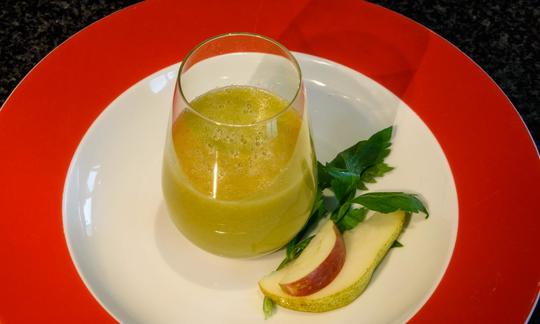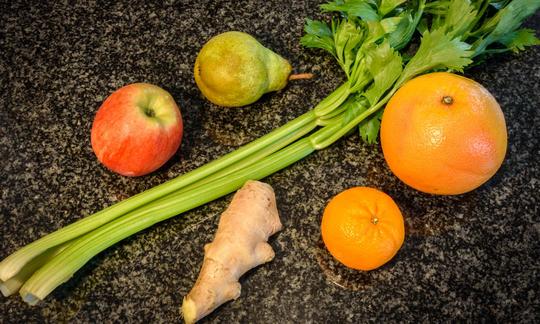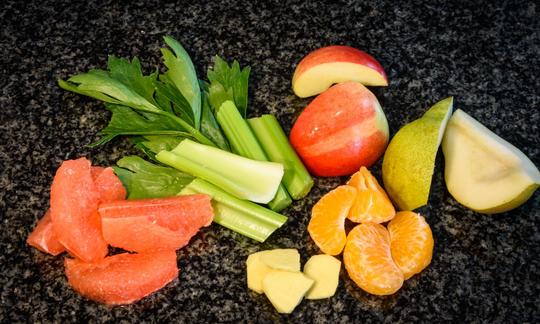Sweet and Tart Morning Smoothie with Grapefruit and Ginger
raw-vegan
Ingredients (for servings, )
| ½ | Apple, raw, with peel (2.6 oz) |
| ½ | Pears, raw (organic?) (3.1 oz) |
| ½ | Grapefruit, raw (organic?) (6.9 oz) |
| ½ | Mandarin, raw (organic?) (1.5 oz) |
| 2 stalks | Celery (bleached celery), raw (organic?) (2.1 oz) |
| ⅜ oz | Ginger, raw (organic?) |
Equipment
- blender
- juicer
- vegetable peeler
Type of preparation
- food preparation without heating
- blend
- juice
- peel
Preparation
Wash the apple and pear well, peel, and remove the cores.
If you are using organic fruit, you can add it to the blender without peeling.
Peel the grapefruit and mandarin. Wash the celery and remove the strings from the celery stalks by peeling them off along the length of the celery rib. Cut everything into pieces that will easily fit into the juicer.
Peel the ginger. Juice the ginger along with the grapefruit, mandarin, and celery pieces.
Add the juice and the apple and pear chunks to the blender and blend until smooth.
|
Nutritional Information per person
Convert per 100g
|
2000 kcal | |
|---|---|---|
| Energy | 98 kcal | 4.9% |
| Fat/Lipids | 0.39 g | 0.6% |
| Saturated Fats | 0.07 g | 0.3% |
| Carbohydrates (inc.dietary fiber) | 25 g | 9.2% |
| Sugars | 18 g | 19.9% |
| Fiber | 4.4 g | 17.4% |
| Protein/Albumin | 1.4 g | 2.7% |
| Cooking Salt (Na:26.0 mg) | 66 mg | 2.8% |
| Essential micronutrients with the highest proportions | per person | 2000 kcal | |
|---|---|---|---|
| Vit | Vitamin C (ascorbic acid) | 45 mg | 56.0% |
| Elem | Potassium, K | 368 mg | 18.0% |
| Vit | Vitamin K | 12 µg | 15.0% |
| Vit | Vitamin B9, B11 (Folate, as the active form of folic acid) | 29 µg | 15.0% |
| Min | Copper, Cu | 0.13 mg | 13.0% |
| Vit | Vitamin B6 (pyridoxine) | 0.12 mg | 9.0% |
| Vit | Vitamin B5 (Pantothenic acid) | 0.46 mg | 8.0% |
| Vit | Vitamin A, as RAE | 61 µg | 8.0% |
| Elem | Magnesium, Mg | 21 mg | 6.0% |
| Vit | Vitamin B1 (Thiamine) | 0.07 mg | 6.0% |
Detailed Nutritional Information per Person for this Recipe
The majority of the nutritional information comes from the USDA (US Department of Agriculture). This means that the information for natural products is often incomplete or only given within broader categories, whereas in most cases products made from these have more complete information displayed.
If we take flaxseed, for example, the important essential amino acid ALA (omega-3) is only included in an overarching category whereas for flaxseed oil ALA is listed specifically. In time, we will be able to change this, but it will require a lot of work. An “i” appears behind ingredients that have been adjusted and an explanation appears when you hover over this symbol.
For Erb Muesli, the original calculations resulted in 48 % of the daily requirement of ALA — but with the correction, we see that the muesli actually covers >100 % of the necessary recommendation for the omega-3 fatty acid ALA. Our goal is to eventually be able to compare the nutritional value of our recipes with those that are used in conventional western lifestyles.
| Essential fatty acids | per person | 2000 kcal |
|---|---|---|
| Alpha-Linolenic acid; ALA; 18:3 omega-3 | 0.02 g | 1.0% |
| Linoleic acid; LA; 18:2 omega-6 | 0.12 g | 1.0% |
| Essential amino acids | per person | 2000 kcal |
|---|---|---|
| Tryptophan (Trp, W) | 0.01 g | 4.0% |
| Phenylalanine (Phe, F) | 0.06 g | 4.0% |
| Threonine (Thr, T, irreversibly transaminated) | 0.03 g | 3.0% |
| Valin (Val, V) | 0.04 g | 3.0% |
| Isoleucine (Ile, I) | 0.03 g | 2.0% |
| Leucine (Leu, L) | 0.04 g | 2.0% |
| Lysine (Lys, K, irreversibly transaminated) | 0.05 g | 2.0% |
| Methionine (Met, M) | 0.01 g | 1.0% |
| Vitamins | per person | 2000 kcal |
|---|---|---|
| Vitamin C (ascorbic acid) | 45 mg | 56.0% |
| Vitamin K | 12 µg | 15.0% |
| Vitamin B9, B11 (Folate, as the active form of folic acid) | 29 µg | 15.0% |
| Vitamin B6 (pyridoxine) | 0.12 mg | 9.0% |
| Vitamin B5 (Pantothenic acid) | 0.46 mg | 8.0% |
| Vitamin A, as RAE | 61 µg | 8.0% |
| Vitamin B1 (Thiamine) | 0.07 mg | 6.0% |
| Vitamin B2 (Riboflavin) | 0.07 mg | 5.0% |
| Vitamin B7 (Biotin, ex vitamin H) | 2.6 µg | 5.0% |
| Vitamin B3 (Niacin) | 0.58 mg | 4.0% |
| Vitamin E, as a-TEs | 0.39 mg | 3.0% |
| Essential macroelements (macronutrients) | per person | 2000 kcal |
|---|---|---|
| Potassium, K | 368 mg | 18.0% |
| Magnesium, Mg | 21 mg | 6.0% |
| Calcium, Ca | 39 mg | 5.0% |
| Phosphorus, P | 31 mg | 4.0% |
| Sodium, Na | 26 mg | 3.0% |
| Essential trace elements (micronutrients) | per person | 2000 kcal |
|---|---|---|
| Copper, Cu | 0.13 mg | 13.0% |
| Manganese, Mn | 0.10 mg | 5.0% |
| Iron, Fe | 0.34 mg | 2.0% |
| Zinc, Zn | 0.20 mg | 2.0% |
| Selenium, Se | 0.52 µg | 1.0% |
| Iod, I (Jod, J) | 1.9 µg | 1.0% |
| Fluorine, F | 4.4 µg | < 0.1% |
This delicious, revitalizing smoothie combines the tart sweetness of grapefruit with aromatic ginger and a fresh fruity flavor.
Serving size: This recipe for 2 servings makes about 300–400 ml per person, depending on the size of the fruit used.
Celery: Both the leaves and stalks can be used in a variety of dishes. Celery’s typical aroma is a result of the essential oils it contains, which in combination with the bitter substances results in its fresh, clean flavor. The high potassium content causes celery to have dehydrating and diuretic effects, which patients on dialysis should take into account. Celery also contains vitamins and polyphenols with antioxidant effects that decrease when the celery is stored for a longer time.
Differences between juice and smoothie: While juicing produces a liquid juice, a smoothie is thicker and creamier. Unlike with juice, smoothies contain the entire fruit, sometimes even the skin. The smoothie base therefore consists of the fruit pulp or purée; additional liquid can be added to obtain the desired consistency.
In contrast to juices, smoothies have the nutritional advantage that no nutritional substances are lost. With smoothies, you get the fiber contained in the fruit. Fiber is of great importance for intestinal health. It also ensures that the sugar from the fruit is more slowly absorbed into the bloodstream than with freshly squeezed juice. Drinking smoothies also makes you stay full for longer. This sweet and tart smoothie is actually a combination of a juice and a smoothie.
Grapefruit: The grapefruit is the result of a cross between an orange and a pomelo. Grapefruit has a relatively high vitamin C content, very few calories, and a slightly bitter to bitter taste. Grapefruits that have a more reddish color are generally sweeter. The glycoside naringin, which is also responsible for the bitter flavor, has antioxidant and lipid-lowering effects. In addition, the bitter substances in grapefruit influence our digestion in that they increase the production of gastric juice and cause us to feel full. However, it is important not to take medications with grapefruit because of possible interactions. These interactions occur because waste products of nutritional substances in grapefruit functionally restrict certain liver enzymes that are important for breaking down specific active substances.
Purchasing and preparing celery: Fresh celery stalks are pale white to yellow or light green in color. Choose medium-size stalks since these have fewer strings and can be eaten without peeling. When bent, fresh celery stalks will break immediately. It is best to store celery in the crisper of your refrigerator. New studies have shown that celery should be eaten within 5–7 days since the effects of the antioxidants it contains diminish after this time.
Preparing the smoothie without pulp: Blending the celery in the blender gives the smoothie a stronger celery flavor. Blending the mandarin or grapefruit causes more bitter substances to be released, which can cause the smoothie to be quite bitter and tart. Each person has to decide for themselves how bitter they want their smoothie to be.
Adjusting the consistency: Based on the information in the notes (Differences between juice and smoothies), you can weigh the advantages and disadvantages of the two. We find this tasty morning smoothie to be the best choice as it is a combination of the two, but you do have to clean two machines afterwards.








